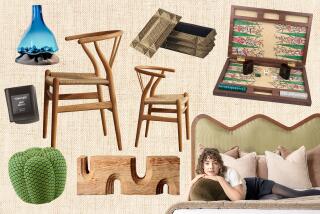Zsolnay, the Last Word in Antiques
âFrom A to Zâ in antiques usually ends with Zsolnay, a popular pottery from Hungary. Zsolnay was founded in 1862 by Ignac Zsolnay at Pics. After 1878, the firm used a mark that pictured five church towers.
At first they made earthenware, but by the 1880s they were making decorative vases and centerpieces based on ideas from Turkish, Peruvian, pre-Columbian and Chinese ceramics. The Art Nouveau style that was popular at the time also inspired some designs.
In the 1890s, they developed iridescent luster glazes that are still in use. An old vase more than 10 inches high with unusual designs, lustrous glaze and the five-tower mark of Zsolnay will sell for $1,000 to $3,000.
*
Question: I cleaned out my motherâs house and found a box filled with plastic doll furniture. Some pieces are too big to be used in a dollhouse. Thereâs a large dining-room suite, a living-room sectional sofa and a set of nursery furniture, including a crib, playpen and Bathinette. All the pieces are marked âIdeal.â Did Ideal make a huge dollhouse to hold this furniture? Is plastic dollhouse furniture from the â50s collectible?
*
Answer: The Ideal Toy Co. started making small, plastic doll furniture in 1947. Early room sets came with kits to make a floor and walls for a room. The pieces could also be used in the inexpensive metal dollhouses produced by several toy companies after the war.
Your larger furniture is from Idealâs Young Decorator series, made from 1950 to 1952. It was sized for a 6-inch doll, not for a dollhouse. Each room set came with a floor plan on which a child could arrange the furniture. Idealâs plastic doll furniture, both small and large, is popular with collectors. The nursery Bathinette alone sells for $55.
*
Q My father was a ham radio operator from 1920 to 1953. He routinely exchanged âcallingâ postcards with the other amateur radio operators he reached. The cards list the date, time and frequency of the radio contact. I have inherited 200 of these postcards, but I can no longer store them. Can you think of anyone who would be interested in them?
*
A First, check with other family members. One of your fatherâs other children or grandchildren might be happy to take the postcards off your hands. Some of the most interesting could make a good wall display.
If that is not an option, call a local historical society or an amateur radio club. If there arenât any or theyâre not interested, you could contact one of the other hundreds of amateur radio clubs in the country.
You might even try Internet chat rooms and online auctions. Or you could place an ad in one of the publications geared to ham radio operators. Someone would love to own the postcards.
*
Q What can you tell us about a lightweight, modern-looking metal chair thatâs marked âOriglia, Sedia Aria, Italy, Design Luigi Origliaâ? I have checked modern-design books and cannot find a designer by this name.
*
A Luigi Origlia is a contemporary Italian designer. He is best known for his streamlined stacking chairs, which sell primarily to offices and schools. The Italian words âSedia Ariaâ can be translated as âair seatâ in English. That is probably the name of your chairâs design.
*
Q My uncle knew that I admired a ship-in-bottle that he displayed on his mantel for as long as I can remember. He died a few months ago and left the model to me. I never asked him how the ship fit inside the bottle. Do you know?
*
A The folk art of placing small models of ships or other scenes inside bottles originated among sailors, who took up the hobby to keep busy on board ship. It was a popular pastime during the last half of the 19th century.
The ship model was assembled outside the bottle. Its masts, spars, sails and rigging were hinged so they could be folded down close to the deck. Long cotton threads were attached to the rigging. The âseaâ--the putty or mixed-material base on which the model would sit inside the bottle--was inserted using a long, thin tool.
After the base was smeared with glue, the model was inserted through the bottle neck. When the glue dried, the cotton threads attached to the rigging were pulled to raise the masts. The cotton threads were then carefully burned off and the bottle sealed with a cork.
For a listing of helpful books and publications, include a self-addressed, stamped (55 cents) envelope to Kovels, Los Angeles Times, King Features Syndicate, 235 E. 45th St., New York NY 10017.
Current Prices
Current prices are recorded from antiques shows, flea markets, sales and auctions throughout the United States. Prices vary because of local economic conditions.
* Illustrated steamboat shipping bill for shipment on the Fulton from Pittsburgh to St. Louis, dated March 9, 1839, 10 by 8 inches, $35.
* Food slicer, cast iron, Enterprise Mfg. Co., Philadelphia, pat. June 5, 1888, 16 1/2 inches, $270.
* Buddy âLâ Wrigleyâs truck, tractor-trailer with electric headlights, doors open, removable trailer roof, green with logo on side of trailer, 1950s, 24 inches, $475.
* Firefighterâs helmet, white painted leather, brass front plate marked âHumane 1--Pottsville, Pa. 1830,â by Cairns & Bros., New York, $550.
* Madame Alexander doll, Little Genius, blue sleep eyes, organdy dress, tag, c. 1949, 11 inches, $600.
* Brass surveyorâs transit theodolite, signed on dial, lacquered, 1929, W.&L.E.; Gurley, Troy, New York, 13 1/2 inches, $1,000.
More to Read
The biggest entertainment stories
Get our big stories about Hollywood, film, television, music, arts, culture and more right in your inbox as soon as they publish.
You may occasionally receive promotional content from the Los Angeles Times.










